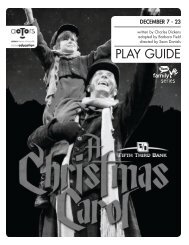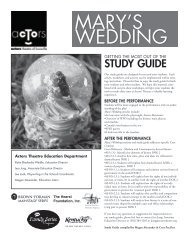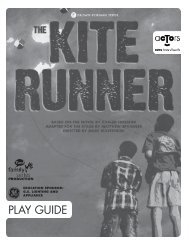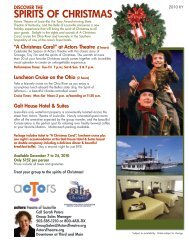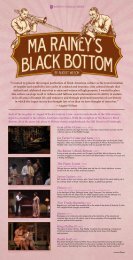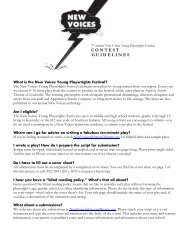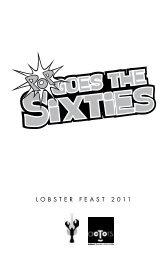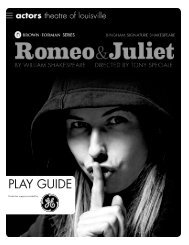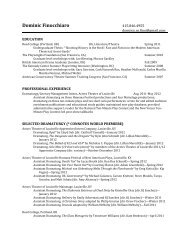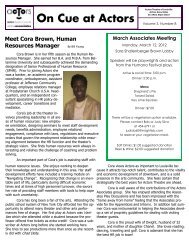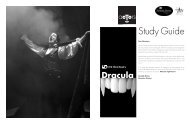Shipwrecked! - Actors Theatre of Louisville
Shipwrecked! - Actors Theatre of Louisville
Shipwrecked! - Actors Theatre of Louisville
You also want an ePaper? Increase the reach of your titles
YUMPU automatically turns print PDFs into web optimized ePapers that Google loves.
<strong>Theatre</strong> in Louis' Day<br />
At the turn <strong>of</strong> the twentieth century, the British theatre scene was divided into two distinct halves: “<strong>Theatre</strong>” and "Music<br />
Hall". <strong>Theatre</strong> was attended by the upper classes and featured dramas and classics produced in large ornately<br />
decorated theaters. Music Hall was produced in smaller auditoriums on simple raised platforms. The audience<br />
consisted <strong>of</strong> the lower classes, and the plays were comedies or vaudeville acts: songs, skits, displays <strong>of</strong> various talents<br />
such as acrobatics, and even travel stories. It is in music halls that Louis and his touring company would have staged<br />
his incredible tales.<br />
Here’s a look at some <strong>of</strong> the early-twentieth century stage techniques that Louis and<br />
Co. would have used when putting on their entertainment:<br />
A poster for Le Chat Noir<br />
Testing…testing…1,2,3…hello?<br />
There were no microphones in Louis’ day. Nor were there speakers or<br />
endless databases <strong>of</strong> computerized sounds to insert into a show. Instead,<br />
theatre-makers had to create sound effects on the spot, using various<br />
contraptions and found materials. For instance, to make thunder, sound<br />
techs hit a large metal sheet known as a thunder sheet with a mallet, or<br />
rolled cannonballs down a large chute known as a thunder run. There<br />
were also rain boxes and wind machines. By the time Louis was hitting<br />
the stage, he would have also been using a “high-tech” alternative: the<br />
gramophone. Now, pre-recorded sounds could be played on stage—you<br />
could have the neigh <strong>of</strong> a real horse rather than a human imitation coming<br />
from the wings.<br />
Black Cats and Shadows<br />
Shadow puppet shows were performed both on the streets and in<br />
cabarets. Screens were hoisted onto the stage or positioned in front <strong>of</strong><br />
the portable booths <strong>of</strong> street performers. Candles, oil lamp, or limelight<br />
would backlight the screens, and puppets made <strong>of</strong> tin and card performed<br />
between the light and the screen. Street shadow shows were called<br />
Galanty Shows. During the day, street puppeteers put on popular Punch &<br />
Judy shows—comedies performed by a single puppeteer that featured the<br />
adventures <strong>of</strong> the mischievous, hook-nosed Punch and the arguments he<br />
had with his wife, Judy. At night, the puppeteers transformed the booths<br />
and performed the Galanty Shows. Stage shadow shows were inspired by<br />
productions from the infamous Bohemian French cabaret Le Chat Noir.<br />
A gramophone<br />
And then there was…electricity!<br />
In the end <strong>of</strong> the nineteenth century, gas lamps and a gaseous mixture<br />
known as limelight were used to light the actors and scenery up “on the<br />
boards.” These highly flammable gasses, combined with the wooden<br />
architecture <strong>of</strong> the theatres, led to many disastrous fires. Luckily for Louis<br />
and his audiences, the turn <strong>of</strong> the century marked the widespread use<br />
<strong>of</strong> electric lights in the theatre (the first electric lights appeared in British<br />
theatres in the 1880s).<br />
Punch and Judy Show<br />
7



